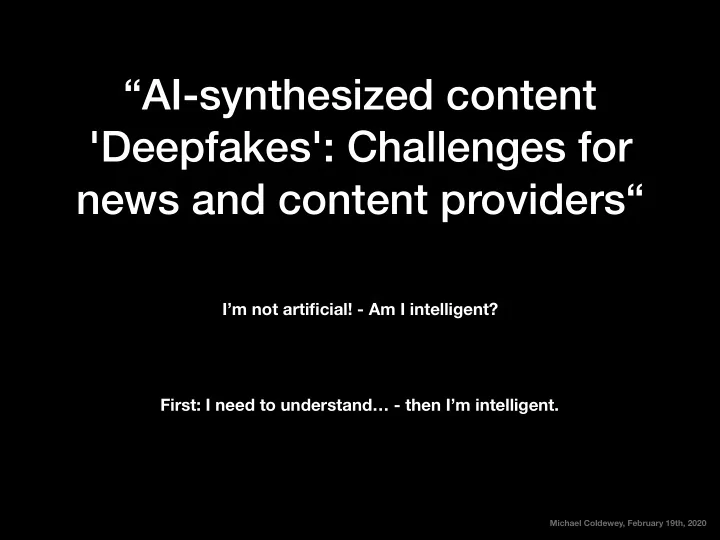

“AI-synthesized content 'Deepfakes': Challenges for news and content providers“ I’m not artificial! - Am I intelligent? First: I need to understand… - then I’m intelligent. Michael Coldewey, February 19th, 2020
Almost all my life, people told me: “Ah, you are working in animation business! So now the computer is doing it!” - I took it as an insult. A disrespect of the creativity and skills of all the talented animation artists. Now I must confess, that I am getting closer to the answer I hated so much: “Sorry, yes. The fuck’n computer…!” Michael Coldewey, February 19th, 2020
How and why is this happening? Computers are able to see (sensors, image analytics) and hear (Siri, Alexa). Machine learning becomes Artificial Intelligence when the computer takes over the supervision from the human. Based on knowledge and running algorithms, computer software learns and produces results. Results humans can take for their decisions. (If they want to) A self driving car or software writing scripts or, in my field: the choice of images to create a new one: Deep Fake A computer uses it’s deep neural network to learn all about the look of a character, the images, the movements and audio of two different sources to combine it for a new clip. Michael Coldewey, February 19th, 2020
In entertainment: The manipulation of images after the shooting is in practise since the beginning of filmmaking. The former George Lucas’ company ILM (STAR WARS) calls this procedure since the late 1970s: Visual Effects (VFX). Their latest most famous example is the manipulation of the age of actors in Martin Scorsese’s movie THE IRISHMAN: Michael Coldewey, February 19th, 2020
ILM went through a long, expensive process of VFX producing: including a special camera rig: And CG models, shapes and facial rigs: Michael Coldewey, February 19th, 2020
ILM used AI software to learn and understand the facial expression and acting of the actors especially when they were 20 or 30 years younger. Combined with the now produced footage, they created the younger versions of the characters. Michael Coldewey, February 19th, 2020
A YouTuber did the same with latest deep fake software, available for everyone. It took him just seven days to re-create different versions of ages of the actors with a better result, than ILM’s: Michael Coldewey, February 19th, 2020
Not only face replacement… also water simulations and everything that moves will be learned by machines and implemented into other footage. Dan Deleeuw, VFX Supervisor: “you can expect machine learning to have a role just about everywhere when it comes to visual effects” Michael Coldewey, February 19th, 2020
The comedy effect: (machine) learning: In this case: collecting images with blond politicians. (machine) learning: typical behaviours, movements: Facial expressions… Mixing the learned content with an other source. … Michael Coldewey, February 19th, 2020
In public, free and not regulated, software easy o use: Deep fake as comedy, here Jeff White, so called Dr. Fakenstein Michael Coldewey, February 19th, 2020
Why is it important to look at phenomena “deep fake”? Because deep fake produced by AI software is cheaper and easier to use, we all face a new era: Biggest thread for the future might be, that elections will be influenced with deep fake fake-videos… by foreign nations, extremists or even industries or religious leaders. … Michael Coldewey, February 19th, 2020
Why is it important to look at phenomena “deep fake”? Financial crises, because of audio deep fakes. Devices like Alexa can speak with the voice of celebrities, so why not using it for crime? For example a false CEO phone call transferred US$10 million. AI characters like virtual influencer Lilmiquela generates millions of followers, without having to pay talents to perform. China TV uses a news anchor fully virtual, who can work 24h a day. So called “revenge porn” could ruin people’s reputation. Michael Coldewey, February 19th, 2020
How to handle deep fake? First you need to find out, if there is a deep fake used. So there is a race between two AI software based creations: the ones doing deep fakes, and the ones trying to detect them. The harm deep fake can cause is, that either people believe it is true, what they see, or make believe what is true is a (deep) fake. Companies like Zerofox developing software that detects deep fake and the US Pentagon founded a special agency, called DARPA (Defense Advanced Research Projects Agency) working on this topic. FaceBook is spending $10 million and partnering with Microsoft to get ahead of deep fakers spreading into the social media. Fabula AI is a detection of false video content. AI based software called Geometric deep learning. YouTube deletes videos, that are detected to be fake. At least they claim. I know personally people, hired by Google and Facebook, to develop detecting AI software. Michael Coldewey, February 19th, 2020
My job? As a Professor at the Munich Filmschool, I am the one, the students look at, when it comes to VFX, Animation and everything, that can’t be filmed in real life. As a background in Animation and VFX, they trust me. When the first time I presented Deep Fake technology in a class, the film students almost couldn’t believe that it is so easy to make. I used Deep Fake to bring every one to full alert. The responsibility for any image creator is high. They influence and form (new) reality. Humans do trust images way more than spoken or written words. I hope that the audience’s learn curve is always at the same level and speed than the possibilities of creation. BTW: This is one of the most important points to understand and enjoy ART. Artificial Intelligence is NOT a thread! It offers new possibilities for man kind for a better future. Michael Coldewey, February 19th, 2020
Recommend
More recommend